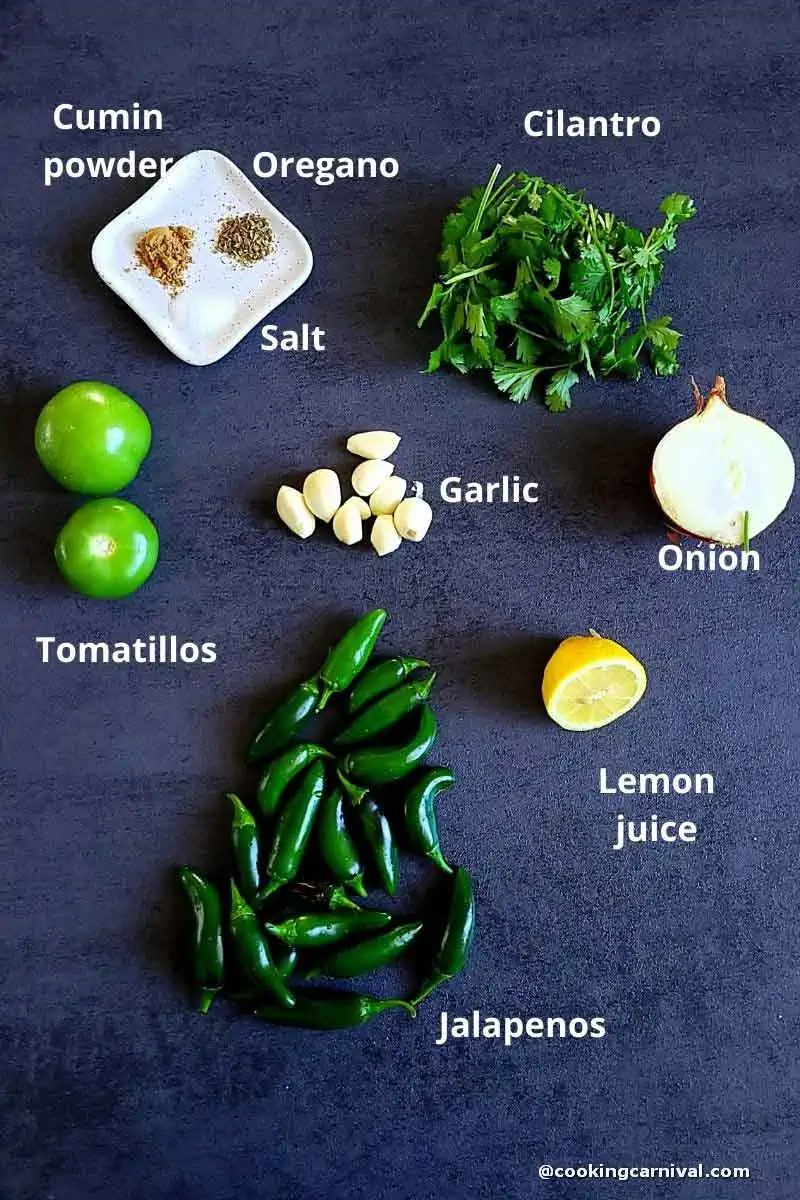Are you looking for a different type of salsa recipe to try that is spicy and full of flavors?? Well then our easy, highly addictive, and delicious roasted Jalapeno Salsa is what you need.
This Salsa is perfect in tacos, with tortilla chips, empanadas, enchiladas, or in tostadas. It is easily customizable to your heat preferences.
Let’s learn to make roasted jalapeno salsa at home with step-by-step pics and videos. Once you try this recipe, it will become a staple in your kitchen.

Jump to:
This is my second year with a vegetable garden here in Arizona, and I’m a little surprised with how good my pepper plants are growing. It seems like they really like the hot Arizona summer weather.
So far, I have harvested:
- Shishito peppers
- Bell peppers
- Pimento peppers
- Jalapeño peppers
In fact, our today’s recipe, Jalapeno salsa, the jalapenos comes from my small garden.
To me, there is no better snack than chips and salsa. They are the #1 reason I love to go to Mexican Restaurants. 🙂
About this recipe
Nothing is better than making lip-smacking salsas at home. It is so much better than the store-bought and this Super Easy Jalapeño Salsa fits the bill perfectly!
This spicy salsa is made with roasted jalapenos, tomatillos, onion, garlic, cilantro, salt, and lemon juice.
Unlike most salsas where the peppers are added to a base of tomatoes or tomatillos, jalapeño peppers are the base of this roasted salsa which gives it its distinct taste and extra heat.
It is loaded with loads of flavors and goes great with chips or it can be drizzled on any number of Mexican dishes.
The process of making this salsa is so easy. Roast the ingredients, throw them in a blender/food processor and pour everything into a jar to have on hand for whenever you need some salsa.
Ingredients required
- Fresh jalapeños: You will need fresh jalapeño peppers to make a batch of this salsa. I love my salsa spicy so used whole jalapenos. To make the salsa less spicy, slice in half and remove the seeds before roasting.
- Tomatillos: I love to use tomatillos for a burst of citrusy flavor. Feel free to substitute it with Roma tomatoes.
- Garlic: garlic adds the perfect rich bite of flavor to this spicy garden salsa. But if you or your family or friends aren’t fans of garlic, feel free to avoid it. Make sure to use fresh garlic, not the already peeled one.
- Lime juice: For refreshing flavors.
- Spices: Salt, cumin powder, and oregano.
- Yellow onion: is the best flavor for this particular salsa, but you can substitute it with white onion.
- Cilantro: for the extra flavors.

Step by step process
Step 1 – Oven roasts the tomatillos, jalapeño, garlic, and onion on broil
- Line the cookie pan sheet with aluminum foil.
- Turn on the oven on broil on high.
- Take whole jalapenos, onion, garlic, and tomatillos on a cookie pan sheet. Drizzle olive oil and sprinkle ½ teaspoon salt over the veggies.
- Place the cookie pan sheet in an oven. Broil the veggies for 10 minutes or until charred, flipping halfway through.
- Take out the pan from the oven and let the roasted ingredients cool down.
Step 2 – Blend
- Remove the stems from the jalapenos.
- Next, I transferred the roasted ingredients to a food processor (or you can use a blender or hand blender) along with cilantro, ½ teaspoon salt, cumin powder, oregano, and lemon juice. Pulse it a few times until desired consistency is reached. I kept it chunky.

Step – 3 Chill and serve:
- You can eat this Jalapeno salsa right away, or chill it in the refrigerator until you’re ready to serve it. Enjoy it with chips, tacos, tostadas, chimichangas, and many more Mexican dishes.
- Store it in an air-tight container or jar. It stays fresh for up to 2 weeks in the refrigerator.

Notes, pro-tips, and quick FAQs
- Don’t over-process the salsa. You want it to be slightly chunky for the best texture. No pureeing here.
- To make the salsa less spicy, slice in half and remove the seeds before roasting.
- If you are going to remove the seeds, use gloves while working with the jalapeños too. Also, make sure to NOT touch your face to avoid any burning!
- Everyone will have different preferences regarding how salty they prefer this salsa to be, so I recommend starting with small amounts and then adding more to the taste.
- You can easily double or triple this recipe.
- I prefer the roasting method for a more intense flavor. But you can boil the ingredients too.
- I highly recommend adding the jalapeno pepper in small batches you make this Salsa. This will give you a good idea of the heat level your palate prefers.
- You can roast jalapenos, tomato, garlic, and onions in Pan or in an air-fryer too.
- You can always substitute a Serrano for the jalapeno.
- To make this salsa milder, remove the seeds and white part from the jalapenos before roasting them.
Yes, this jalapeno salsa is VERY spicy as the main ingredient is jalapeno. The jalapeño adds a decent amount of heat to this salsa. I would say the spice level is 5/5, 5 being the highest heat level. If you don’t like spicy foods, remove the seeds from the pepper before roasting it with the other ingredients.
Sometimes your salsa doesn’t come out exactly to your liking. Keep in mind that the ingredients are all-natural products and can vary in freshness and flavor due to seasonal differences and how the ingredients have been handled.
One time when you buy peppers they may be super hot and the next time you buy the exact same pepper is very mild.
very runny: simmer until it has reduced to the desired consistency.
very thick, add water 2 tablespoons at a time until the desired consistency is reached.
hot, 1 to 2 teaspoons of sugar or maple syrup.
Start making adjustments, in small quantities.
You can boil the jalapenos, onion, tomatillos, and garlic. However, I think the flavor of the salsa becomes bland.
Oven Roasting the jalapenos and other vegetables
You can also oven roast the jalapeños and vegetables. Place them on a baking sheet lined with aluminum foil and then roast them at 400 degrees F. for approximately 30 minutes turning once.
Some variation
You can any fruits like Mango, Peach, Pineapple, strawberry to this salsa. Once vegetables are roasted, add any fruit of your choice while grinding salsa in a food processor.
You can add sugar or agave to make this a little bit sweeter.
This salsa will be delicious, fresh and so much better than the salty jarred varieties. I can guarantee that much.

More Dipping sauce
Have you tried this Recipe? Please feed us with your feedback, ★ star ratings, and comments below.
You can also FOLLOW me on FACEBOOK, INSTAGRAM, and PINTEREST for more fabulous recipes and updates.
Subscribe to our YouTube Channel for tasty and easy video recipes.
Jalapeno Salsa
Ingredients
- 180 grams – Fresh Jalapenos 15 medium sized – See notes
- 2 big – Tomatillos Cut into half
- 8 – big garlic cloves
- ½ – brown onion cut onto 4 pieces
- 1 cup cilantro washed
- ⅓ cup Lemon juice
- 1 teaspoon – salt or to taste
- ½ teaspoon oregano
- ½ teaspoon cumin powder
- 1 tablespoon olive oil
Instructions
Before starting the recipe, I would like to tell you that this salsa is VERY spicy. If you want to make medium or mild spicy, please read the notes.
Step 1 – Oven roasts the tomatillos, jalapeño, garlic, and onion on broil
- Line the cookie pan sheet with aluminum foil.
- Turn on the oven on broil on high.
- Take whole jalapenos, onion, garlic, and tomatillos on a cookie pan sheet. Drizzle olive oil and sprinkle ½ teaspoon salt over the veggies.
- Place the cookie pan sheet in an oven. Broil the veggies for 10 minutes or until charred, flipping halfway through.
- Take out the pan from the oven and let the roasted ingredients cool down.
Step 2 – Blend
- Remove the stems from the jalapenos.
- Next, I transferred the roasted ingredients to a food processor (or you can use a blender or hand blender) along with cilantro, ½ teaspoon salt, cumin powder, oregano, and lemon juice. Pulse it a few times until desired consistency is reached. I kept it chunky.
Step – 3 Chill and serve:
- You can eat this Jalapeno salsa right away, or chill it in the refrigerator until you’re ready to serve it. Enjoy it with chips, tacos, tostadas, chimichangas, and many more Mexican dishes.
- Store it in an air-tight container or jar. It stays fresh for up to 2 weeks in the refrigerator.
Roasting in the airfryer
- Preheat air fryerWhen ready, set temperature to 400 F.Clean jalapeños, ensure they’recompletely dry if you rinse them.Now take jalapeno, tomatillo, onion and garlic in an air-fryer basket.Cook for 10 minutes, shake every 3 minutes to ensure jalapeños evenly roast.Check them, if its not done,roast it 5 more minutes.Follow the step no.2 and no.3
Video
Notes
- Don’t over-process the salsa. You want it to be slightly chunky for the best texture. No pureeing here.
- To make the salsa less spicy, slice in half and remove the seeds before roasting.
- If you are going to remove the seeds, use gloves while working with the jalapeños too. Also, make sure to NOT touch your face to avoid any burning!
- Everyone will have different preferences regarding how salty they prefer this salsa to be, so I recommend starting with small amounts and then adding more to the taste.
- You can easily double or triple this recipe.
- I prefer the roasting method for a more intense flavor. But you can boil the ingredients too.
- I highly recommend adding the jalapeno pepper in small batches you make this Salsa. This will give you a good idea of the heat level your palate prefers.
- You can roast jalapenos, tomato, garlic, and onions in Pan or in an air-fryer too.
- You can always substitute a Serrano for the jalapeno.
- To make this salsa milder, remove the seeds and white part from the jalapenos before roasting them.
Nutrition
Warm Regards,
Dhwani.







I use a very similar recipe but I smoke my peppers, onions, and garlic.
Hello
Can this recipe be canned and put through a water bath without cooking first, or do and can you cook this salsa before putting in a water bath?
Thank you and have a blessed day.
Blessings,
Shari